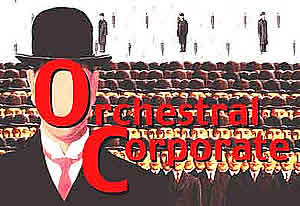|
Interesting article. I enjoyed the run-up but thought
the “industrial = cowboy” link in corporate music has
always been obvious, and is only a fairly limited part of the
corporate music scene. The last page or so was really just stating
the obvious. Here’s a site which gives
some of the other styles in use … http://www.zdnet.co.uk/specials/2002/it-anthems/
To take a couple of your own
examples, I don’t think Robert Eno really fits your universe
of macho composers, and the Broadway musical style (thank you
for the extract from the Xerox musical by the way!) is very distinct
from the cowboy style. Also, in your map, I was surprised
you shoved Stravinsky off to one side with a bunch of less “macho”
composers like Debussy. Perhaps you haven’t seen Fantasia—but
I would say Rite of Spring set the tone for a lot of movie
music, including the hemiola. Thanks again, Peter Judge |
Correspondence
|
Thanks for the feedback and the great link; see my specific musings in response to your observations below. I'm always glad to know some folks outside our little ivory tower are reading ECHO! “Obvious” in the business world is not so obvious in the world of academic musicology; this piece was just a first step into a much larger set of issues …
OK—this stuff is fabulous. (The KPMG jungle mix had me aspirating my Diet Coke.) Where did you guys find all these? I was only looking at the kind of “generic” corporate themes that you can get from production libraries; these obviously can’t have lyrics, and tend to avoid the kind of pop/gospel stylings that KPMG affects so well. But is that page a joke? Do these IT companies use these “anthems” in PR, etc.? I need to know, because I think a follow-up piece on these anthems is in order.
Brian Eno was just in there because he
wrote the Windows 95 start up sound; you are right that he has
nothing to do with the “bold industrial” sound—and,
in my defense, I would argue that it is only that particular
subset of the subset of corporate music called
“industrial” that draws so relentlessly on the cowboy
trope. There are other kinds of industrial than “bold”—and
they often sound closer to the anthems on that page. And corporations
use other styles of music than “industrial” all the
time, when they want a more ingratiating, home-y feel. (One
possible corollary to my argument is that “bold industrial”
is how corporations portray themselves to themselves,
while more soft, pop type sounds are used to construct their
public image.) Or, it may be that the style of corporate
subjectivity has changed, and the music in the Network library
(many of the tracks are 10–12 years old) is just an out-of-date
80s picture of corporate masculinity. The new style seems to
be much more “sensitive” …
Good point—I put Stravinsky after
Debussy because that is a standard connection in music history
(the chart was adapted in some aspects from those I use in teaching
20th-century music history surveys). The line probably goes
Debussy-Stravinsky-Copland-Williams. I recently watched Jaws
again, and John Williams indeed knows every note of the Rite
of Spring. During the class lectures on this material, I
amused us all greatly by arguing that the shark in Jaws
was a kind of macho anti-hero (they named the shark “Bruce”
on the set), and thus “his” music fused traditional
cowboy-like fanfares with the precise dissonant tonal relationships
of the first dance section of the Rite of Spring. (The
one with all the complex hemiolas in it.) Robert Fink |
|
Yes, the songs are genuine, though the
site exists to make fun of them, and many of the songs on them
are either produced by people within the company with a sense
of humour, or remixed by those outside the company. The site was
first put together by a web designer and blogger called Chris
Raettig. His account is here http://corporateanthems.raettig.org/—follow
the links for press. I picked it up as a good way to get traffic
on our site. Since coming to it, I’ve acquired a lot of tracks
that weren’t there at the original, and got a lot of press
coverage. At one stage we were a significant item on CNN, the
BBC, the London Times newspaper, and goodness knows what else.
After several months’ involvement,
I have a different take than Chris’ essentially satirical
one. I (and I think many other people) get affectionate towards
these songs—without actually liking them as music. I wrote
an online article suggesting I might be the Cecil Sharp of industrial
folksong—though that role might go to Jonathan Ward or Steve
Young. http://www.furious.com/perfect/industrialmusicals.html
I see these broad categories: 1. Corporate Anthems: the ones genuinely
commissioned as a means to inspire the troops, and usually having
the opposite affect at corproate get-togethers. The KPMG piece
is an exemplar—and its origin is dealt with in an article
linked from MC
Vitamin D (“two lousy stars”). Anything that comes out of a Consultancy
is most likely in this vein, though they get fresher if they come
from a Far Eastern subsidiary (eg McKinsey) and not through central
PR. However, Cybermedia and Honeywell score well here. 2. Widely circulated piss-takes of corporate
anthems (again KPMG gets most of these—the KPMG Teutonic
master mix is a satire of tedious corporate empire building unfortunately
more tedious than the original). 3. Company songs intended to amuse: The SGI songs come into this category—the
lyrics are clearly light-hearted. 4. Jingles that go on web sites (these
probably shouldn’t be on my site). 5. Spoof versions of “real” songs (Mambo Number Five simply cried out for this treatment and got it). These are meant to be funny and may be
amusing in other ways than intended. 6. Amateur internal songs—I have a
protest song recorded by the OpenMail team in HP when their product
was cancelled. I also understand that Microsoft has many such
songs internally, but keeps a lid on them. Somehow. 7. Traditional company sing-alongs. These
are extinct in the West (or
are they?) but still widely practiced in the East, where a
workforce can be induced to gather for communal spirit-raising.
The IBM song is a superb reminder of the glory days, and the IBM
songbook contains many other lyrics which all (if you want to
read them that way) construct corporate masculinity interestingly
(see “Our
IBM Salesmen”). That should get you started … Peter |
| |
|
Articles
|
|
Nicholson: “Hello Cleveland!” |
|
Interview
|
|
Review Essay
|
| |
|
Reviews
|
| |
|
|
 |

|
 |
